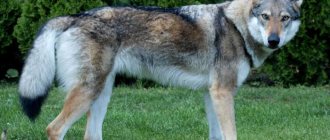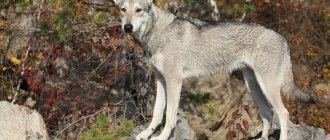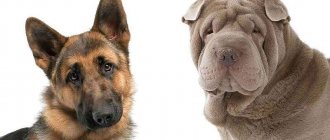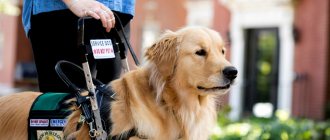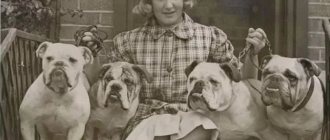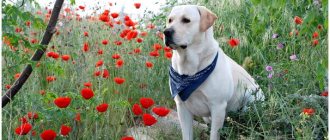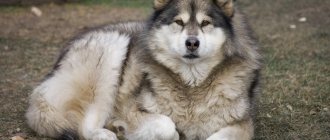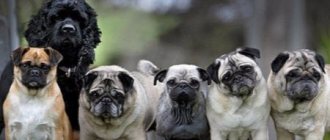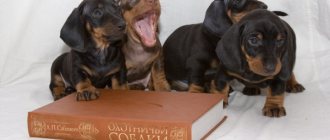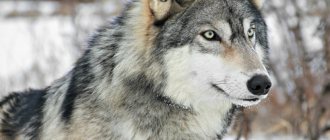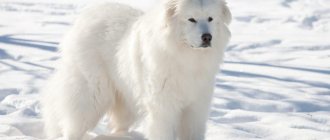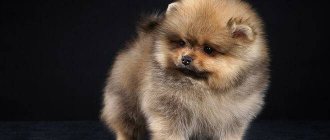American theriologists have proven that the dog (lat. Canis lupus familiaris) is a subspecies of the wolf (lat. Canis lupus). This article will examine the main dog breeds that are similar to their ancestors or are close relatives.
Today there are dog breeders who want to return to the roots - to tame the wolf. And since this is dangerous both for yourself and for others, it is better to take a closer look at the wolf-like breeds already recognized by the International Canine Organization. This way you will get the appearance of all the best features of a domestic dog.
Siberian Husky
The Eskimo dog breed became world famous thanks to the “Great Race of Mercy” in Alaska. Surely, everyone whose childhood was in the 90s remembers the cartoon “Balto” and once dreamed of such a four-legged friend. In 2022, “Togo” with William Defoe was released, where we are finally shown the true story about these amazing snow dogs.
The recognizable bright appearance, love for people and high intelligence allow this breed to be at the peak of popularity all over the world.
Both of these northern sled breeds are among
the top most beautiful dogs
Features of wolfdogs
Wolf dogs are powerful, beautiful, extremely intelligent and highly intelligent animals.
Positive behavioral characteristics and character traits include the following:
- High level of mental abilities, and, as a result, good learning ability . Animals are smart, quickly and correctly grasp the meaning of commands. It is recommended to involve professional dog handlers with extensive experience working with service dogs in training and education.
- Excellent performance characteristics - the instinct inherited from the “wild” ancestor allows you to brilliantly perform a variety of search, investigative and security tasks.
- Devotion, obedience - with a properly constructed education system. Mixed breeds must be included in the hierarchical human-dog social system from birth. In this case, problems with discipline and submission to the owner will not arise.
- Unpretentiousness in food , the ability to go without food for a long time, the absence of special conditions for keeping a wolf-dog. The best option is an open space with the possibility of free walking. As a place to rest and sleep, a spacious enclosure with an insulated floor is enough to provide shelter from heavy rain, piercing winds and severe frost. The enclosure or canopy must be located away from drafts and direct sunlight.
- No special requirements for caring for wolfdogs . So, the coat is combed once a month, and to maintain cleanliness it is enough to bathe your pet only 2 times a year. Other procedures, such as cleaning the eyes, ears, and examining the teeth, are carried out once every 7-10 days. Wolfdogs' claws usually do not require trimming, as they wear down naturally.
- Excellent health . For example, it is noted that wolf dogs are not susceptible to many diseases characteristic of large dogs - joint dysplasia, diseases of the digestive system. Representatives of this breed are considered long-livers - life expectancy often exceeds 20 years.
But these animals also have unfavorable traits that the future owner must keep in mind:
- Animals have a pronounced desire for dominance. For this reason, they are absolutely not suitable for people with a soft, pliable character. The feeling of belonging to the “pack” is preserved in this type of dog for a very long time, and it is important for wolf-dogs to have a leader to whom they obey unquestioningly. The owner's leadership qualities are the key to a successful relationship with the pet.
- It is not recommended for inexperienced owners who have no experience in communicating, raising and training large service-class dogs to have a wolf-dog.
- Not suitable for keeping in an apartment (only real wolf-dogs are not suitable).
- It is forbidden to put wolf-dogs on a chain . This often leads to aggression, including towards the owner and members of his family.
- Doesn't get along well with other animals.
Northern Inuit
This breed originated in Canada and further developed in Great Britain. The Inuit is the result of crossing an Alaskan Malamute, a Siberian Husky and a German Shepherd. Thus, he does not have pure wolf genes.
The Inuit became widely known after playing direwolves in Game of Thrones.
Recognized breeds similar to wolves
Alaskan Malamute
Height: 58-64 cm Weight: 24-38 kg IFF classification: group 5, section 1, No. 243
This is a large sled dog that was bred by the Eskimos to work in the extreme conditions of the north - an aboriginal factory breed. The Malamute is indeed very similar to a wolf and is one of the oldest breeds.
He needs constant physical activity and long walks. Malamutes are very attached to the family and love children. But in training a dog requires a “steady hand.” It is easy to care for such a pet: Alaskans are clean and eat little. Read more about the Alaskan Malamute here.
Siberian Husky
Height: 50-60 cm Weight: 15-28 kg IFF classification: group 5, section 1, No. 270
This is a native sled dog of the Russian Far East. It was obtained from animals that belonged to the tribes of the peoples of Anadyr, Kolyma, and Kamchatka. At the beginning of the 20th century, during the “gold rush”, huskies were brought to the USA, where they were registered by dog handlers.
Husky is an intelligent, hardy breed with a strong hunting instinct. However, they are not suitable for hunting and protection. Husky will be an excellent companion for people with an active lifestyle, because they need constant work of muscles and mind. If you live in the middle zone or in the north of Russia, dream of devoting a lot of time to your pet and love luge sports - then this breed is for you!
Wolfdog of Saarloos
Height: 60-75 cm Weight: 35-48 kg IFF classification: group 1, section 1, No. 311
In 1925, the Dutch breeder Lander Sarloos After Sarlos's death, his wife and daughter continued the breeding work and in 1981 the Dutch Kennel Club recognized the new breed.
The Saarloos Wolfhond looks like a wolf, but is loyal and trainable. In Holland and other countries they are used as guides for the blind and to save people in extreme situations.
These are both independent and very attached animals to their owner.
An interesting feature: Saarloos dogs cannot bark, they only howl like wolves.
Czechoslovakian Wolfdog
Height: 60-65 cm Weight: 20-26 kg IFF classification: group 1, section 1, No. 332
The Czechoslovakian Wolfdog is a relatively new breed - the breed was recognized by the FCI in 1999. The Wolfdog arose as a result of crossing the German Shepherd and the Carpathian wolf. They resemble wolves in everything, even in their inability to bark. But the wolfdog can howl in different ways.
The wolfdog has a strong and independent character, the future owner of the pet must match. Training cannot be called easy, but training is still possible. The main thing is to avoid routine and dilute your activities with fun games.
German Shepherd
- Height: from 58 to 63 cm
- Weight: from 22 to 40 kg
- Life expectancy: 9 to 13 years
- Average cost: from 800 to 1500 dollars
One of the most recognizable breeds in the world, the German Shepherd is a muscular, attentive dog with a noble, regal disposition. This is a born hero . Agile, intelligent, and loyal, German Shepherds love to complete tasks. From search and rescue missions to relief missions, no challenge is insurmountable for their many talents.
This ever-popular dog looks like a wolf, but acts like man's best canine friend. The German Shepherd's protective nature fits well with families, and they are excellent dogs for older children .
German Shepherds love to learn and are easy to train with the right approach using kindness, positive reinforcement and patience. While these energetic dogs are busy, they are calm and even-tempered enough to be able to listen to their owner. But if they have nothing to do, they can easily turn into mischief, so make sure you always have games and activities for them.
Alaskan Klee Kai
Traits : wary of strangers, playful with children
Unlike the Pomsky, the Klee Kai is a pure breed. Smart miniature working dogs love playing outdoors. They love children and make good companions. However, the Klee Kai are wary of outsiders.
Similar to miniature wolves, they adapt well to apartment living. However, daily exercise is required to realize the intense energy of the Klee Kai.
Samoyed husky
Features : friendly, sociable
Having been bred in the harsh conditions of Siberia, Samoyed huskies have incredibly warm fur. Dogs were used to track game, hunt, and keep people warm at night. The snow-white Samoyed resembles a majestic white wolf. However, from its cute face it is clear that this is far from a wild animal.
Did you know that in severe frosts, the coat of the Samoyed husky fluffs up additionally to retain body heat?
Smart and ambitious huskies adore people. Having chosen their owner, they are ready for any interaction. When not exercised, Samoyeds will indicate their displeasure by barking, howling or grumbling.
Belgian Tervuren
Features : anxious, overly active
Intelligent and easy to train, herding dogs native to Belgium have a confident appearance and distinctive coat. Dogs require attention due to separation anxiety. In the human family, such a pet is always with all its paws for any activity.
Did you know that because of their phenomenal speed and obedience, Tervurens were used during World War I and World War II?
What they have in common with wolves is their elongated muzzle and sharp, erect ears. In addition, Tervurens are indispensable for hunting due to their pronounced pursuit instinct.
What is a wolf dog?
Wolf dogs are any breed whose genetic structure has a “wolf” character. This means that any cross with a dog and a wolf is considered a wolf dog.
Wolfdogs can be described as high, medium, or low wolf, depending on how much wolf is given to them.
Some of the breeds on this list do not contain wolves (such as huskies or malamutes) but have similar markings.
However, these types of dogs (both low and high maintenance) present a variety of challenges that even an experienced owner may have difficulty managing.
We'll talk more about how to adopt and breed wolf hybrids at the end of this article.
Quick facts about wolf hybrids:
- They spill A LOT and will shake their fists for two years. In this case, you will need a good brush.
- They are very anxious and destructive when left alone.
- They have very high energy and require intense training every day or they will become boring and destructive.
- They require early socialization to avoid nervousness or aggressive behavior as they develop.
- They can be serious, boisterous people who love to talk and talk.
- They are best suited for large areas or owners who can commit to daily training and ongoing maintenance.
- Some of these breeds are more difficult to raise than others.
Akita Inu
Traits : stubborn, willful
The Akita Inu, a dog breed developed in Japan, is also a relative of wolves. A thick fur coat, pointed ears and an elongated face are characteristic features of the breed. Loyal and affectionate with their family, Akitas are wary of strangers.
What makes the breed unique is its unpredictable and sometimes aggressive character. That is why Akitas received the status of a dangerous breed. Without proper upbringing, such a large pet can cause a lot of trouble.
Tamaskan
Features : physically hardy, tenacious
A wolf-like dog originally from Finland - the Tamaskan - really closely resembles its wild relatives. Bred as working dogs, they have a tenacious nature. Tall and lanky, with a head shape characteristic of wolves, Tamaskans captivate with their stunning yellow eyes.
Smart and agile, Tamaskans cope well with any physical activity. In its absence, they indulge in destructive behavior.
